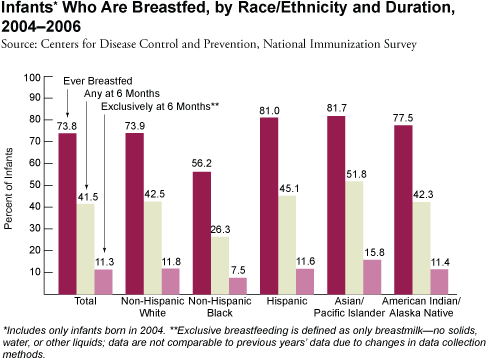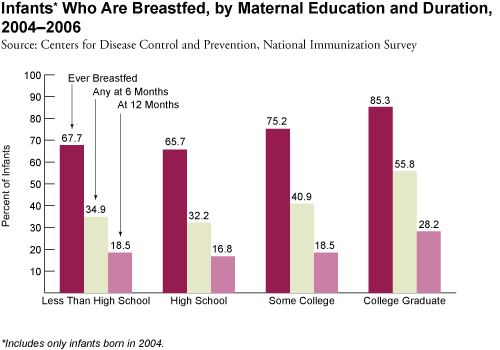- » Home
- » Health Status
- » Maternal Health
Breastfeeding
Breastmilk benefits the health, growth, immunity, and development of infants, and mothers who breastfeed may have a decreased risk of breast and ovarian cancers.1 Among infants born in 2004, 73.8 percent were reported to have ever been breastfed. Non-Hispanic Black infants were the least likely to ever be breastfed (56.2 percent), while Asian/Pacific Islanders and Hispanics were the most likely (81.7 and 81.0 percent, respectively).
The American Academy of Pediatrics recommends that infants be exclusively breastfed— without supplemental solids or liquids—for the first 6 months of life; however, only 11.3 percent of infants born in 2004 were exclusively breastfed at 6 months, and only 41.5 percent of infants were fed any breastmilk at 6 months.
Breastfeeding practices vary considerably by maternal age, educational attainment, and marital status. For instance, infants born to college graduates were most likely to have ever been breastfed (85.3 percent), while infants born to mothers with a high school education or less were least likely (65.7 and 67.7 percent, respectively.)
Research indicates that maternal employment can also affect whether and for how long an infant is breastfed; for instance, mothers working full time are less likely to be breastfeeding at 6 months than those working part time or not at all.2 In 2005, 49.5 percent of mothers with children under 1 year of age were employed, and more than two-thirds were employed full-time (data not shown).3
1 Ip S, Chung M, Raman G, Chew P, Magula N, DeVine D, Trikalinos T, Lau J. Breastfeeding and Maternal and Infant Health Outcomes in Developed Countries. Evidence Report/Technology Assessment No. 153 (Prepared by Tufts-New England Medical Center Evidence-based Practice Center, under Contract No. 290- 02-0022). AHRQ Publication No. 07-E0007. Rockville, MD: Agency for Healthcare Research and Quality. April 2007. ↑
2 Ryan AS, Zhou W, Arensberg MB. The Effect of Employment Status on Breastfeeding in the United States. Women’s Health Issues. 2006; 16: 243-251. ↑
3 U.S. Department of Labor, Bureau of Labor Statistics. Employment characteristics of families in 2006 (USDL 07-0673). Washington, DC: The Department; May 2007. [Table 6] http://www.bls.gov/news.release/pdf/famee.pdf, accessed 12/11/07. ↑


